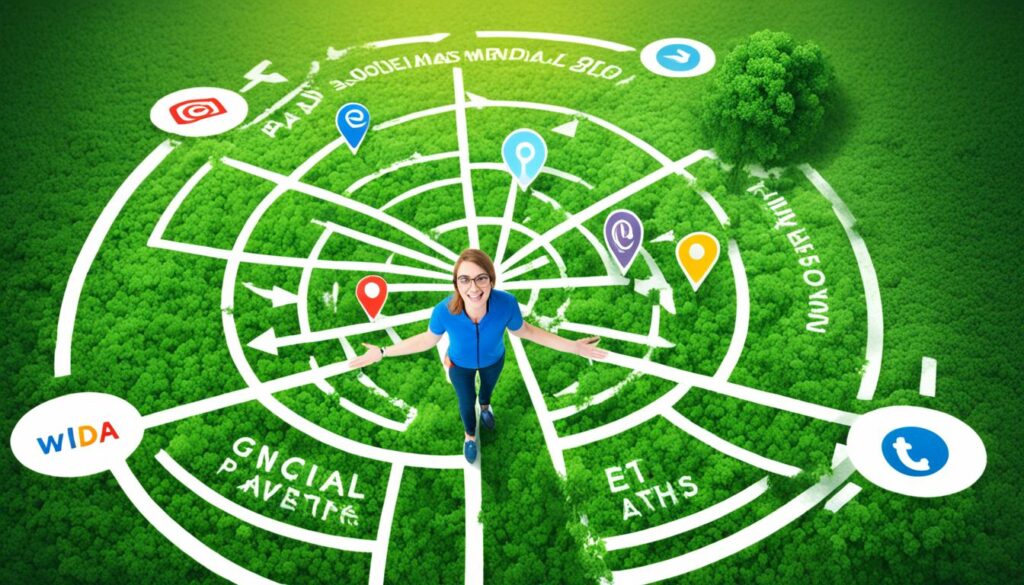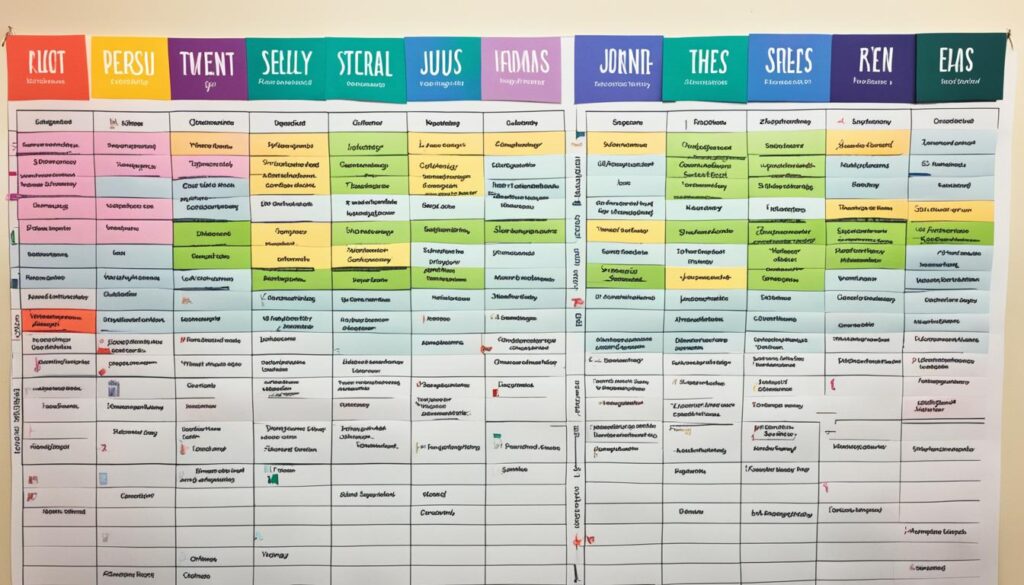
Creating a content map is key to a successful SEO strategy. It guides your audience from their first interaction to turning into customers. A good content map makes every message count and helps meet your marketing goals.
Start by looking at the whole picture and setting your goals. Know your audience and what content you already have. Then, manage your time well, create a calendar, set goals, and be flexible. These steps help make a strong content plan that your audience will like and that will bring results.
Key Takeaways:
- Create a content map or calendar to guide your audience on a clear path towards conversion.
- Assess the big picture and define your objectives to ensure each piece of content contributes to your marketing efforts.
- Understand your audience and evaluate your current content ecosystem to identify gaps and optimize for better results.
- Use effective time management, set milestones and benchmarks, and break down your content into different segments.
- Craft an agile content map that adapts to changes and addresses various content formats and channels for business growth.
Assessing the Big Picture and Defining Your Objectives
Starting with the big picture is key before creating your content map. It's important to know what your brand wants to achieve. This helps ensure your content strategy matches your marketing efforts well, making them stronger together.
To set goals effectively, use SMART goals. These are: specific, measurable, achievable, relevant, and time-bound. They give you a clear path to success. Ensure each content piece supports these goals to boost your marketing’s impact.
Knowing your audience and what they want is crucial. Make buyer personas to understand who you're targeting. Also, check what content you have now. Seeing this, you can find what’s missing and adjust your strategy to fill the gaps.
Being smart with your time is also crucial. It's important to publish content when and where it's most seen. Using good time management in your content plan can make your marketing more effective.
Setting your objectives right is a first, big step to a winning content strategy. By using SMART goals, research on your audience, checking your current content, and managing your time well, you set yourself up for a better chance at success.

Putting It All Together:
| Key Steps | Description |
|---|---|
| Assess the Big Picture | Evaluate your brand's overall goals and aspirations to align your content strategy accordingly. |
| Set SMART Objectives | Create specific, measurable, achievable, relevant, and time-bound goals to guide your content creation. |
| Understand Your Audience | Develop buyer personas and conduct a content audit to gain insights into your target demographic. |
| Practice Effective Time Management | Ensure your content is published at the right time and on the right channel to maximize its impact. |
Creating a Content Calendar and Setting Milestones
A content calendar helps in efficient content mapping. It lets me plan and organize publishing times. This ensures a consistent approach that speaks to my audience. With a content calendar, it's easy to see and organize future content. This helps me space out topics well and link them to events or business needs.
I prefer using a simple spreadsheet or a tool with extra features for my content calendar. This way, I can personalize it to fit what I need. Seeing my plan visually makes it simple to track and update as necessary.

It's important to set milestones in my content calendar for good time management. These milestones mark significant steps or task completions. They help me track how far I’ve come and keep on schedule.
Along with milestones, benchmarks are crucial for hitting performance goals. Setting metrics like page views or engagement lets me see how well my content is doing. Platforms like Google Analytics offer insights to manage and improve my content plan.
An Agile Approach to Content Mapping
"A well-crafted content calendar not only helps me stay organized, but it also allows me to be agile in adapting to changes and optimizing my strategy for better results." – Mary Davis, Content Creator
It's key to be agile for business growth. Staying open to feedback and data helps. This way, I can tweak my content plan based on what my audience likes or market changes. A flexible strategy improves content relevance and engagement.
I segment content for an agile map to suit different formats and channels. This ensures everything fits into one big strategy and boosts marketing. Everything from major content to social media and SEO posts helps attract and keep my audience engaged.
Regularly checking my content's performance and staying aware of trends helps me succeed. It lets me make smart choices and grow my business through my content plan.
| Benefits of Creating a Content Calendar and Setting Milestones |
|---|
| Ensures consistency in publishing content |
| Allows strategic planning based on upcoming events or business priorities |
| Provides a visual overview of future content |
| Enables tracking of content performance and progress |
| Facilitates adjustments and optimizations in real-time |
Crafting an Agile Content Map for Business Growth
Making an agile content map is key to growing a business. In the fast-changing world of content, being flexible is vital. We need to update our map often. This keeps our content in line with what our customers want.
We divide our content into parts to better handle content types and where they go. We create a mix of content. This includes big, powerful pieces, smaller social media posts, and making sure we're seen in searches. This way, our content plan is thorough.
But, remember, our content roadmap can always be improved. We should keep making it better based on what our crowd likes and what the market needs. This helps us better fit our content plan with what our business hopes to achieve. It also guides our followers towards what they want.
To wrap it up, an agile content plan is at the heart of a good content plan that boosts a business. By being flexible and adjusting our content strategy over time, we keep our readers engaged. We also help reach our main business aims.
FAQ
What is a content map?
A content map is also called a content calendar. It's a tool to plan the messages and stories you tell. This tool guides your audience from the start to reaching your main goal.
Why is creating a content map important?
Creating a content map makes your interactions purposeful and productive. It helps you reach your marketing goals. This approach makes your messages work together. It helps your audience and brings good results.
How do I assess the big picture and define my objectives?
Start by really knowing your brand and its goals. Set SMART goals that fit your marketing efforts. Also, know your audience and their needs. Create buyer personas and check your content's quality to see where to improve.
What is the role of a content calendar in content mapping?
A content calendar is key in content mapping. It plans when and where you publish your content. It keeps your approach consistent and organized. This way, you can time your topics well and change plans when needed.
It also makes future content clear and helps manage time well.
How can I create a content calendar and set milestones?
Create a content calendar using a spreadsheet or a specialized tool. The important thing is to see your upcoming content clearly. This strategy makes sure your messages work well together. It gets you to your goals bit by bit.
Setting goals for your content is crucial. Use tools like Google Analytics to track how you're doing and make changes.
Why is crafting an agile content map important for business growth?
Making an agile content map is key for growing your business. The content scene always changes. An adaptable approach keeps you moving forward. By focusing on different content types and channels, you make sure everything supports your strategy well. This keeps guiding your audience toward what they want.











